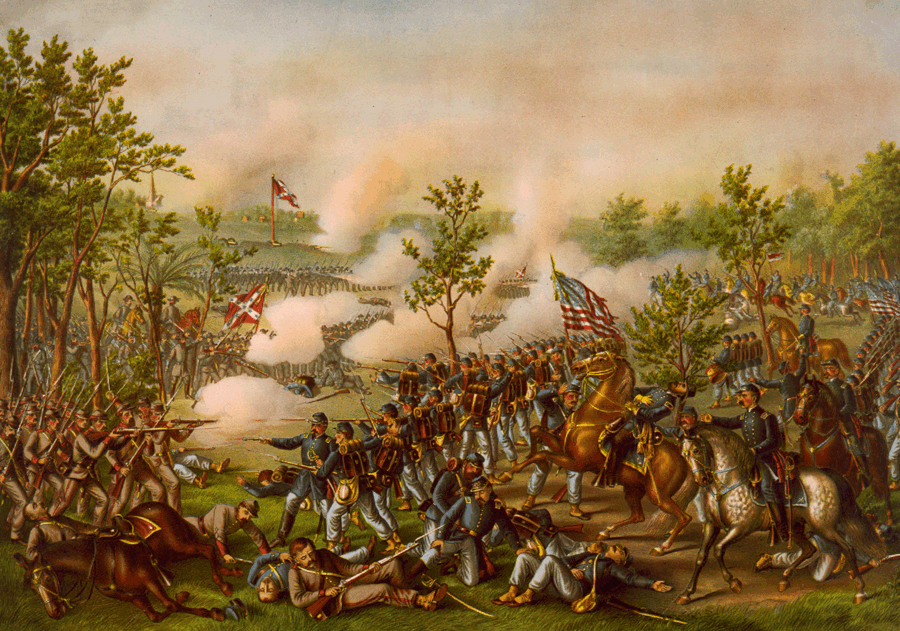While Grant oversaw what was hopefully the final offensive in Virginia, General William Tecumseh Sherman led three armies (Army of the Tennessee, Army of the Cumberland, and Army of the Ohio) on a drive to the vital railroad and communications hub of Atlanta, Georgia. General Joseph E. Johnston led the Confederate resistance. Sherman tried to outmaneuver Johnston while the Confederate commander attempted defensive battles to compensate for his numerical inferiority. Louis Kurz selected three battles from this campaign for his lithographs.
Battle of Resaca

Resaca was the first major battle of the campaign. General James B. McPherson’s Army of the Tennessee had an opportunity to get around the left of the Confederates and into their rear, thus trapping them. He failed to act on it. As a result timely reinforcements under General Leonidas Polk were able to reach Johnston and force the Union into a headlong battle from May 13-15. Johnston ordered a retreat as Sherman again threatened to cut into his rear.
I’m not as knowledgeable on the Atlanta Campaign battles so I can’t comment as much on the accuracy here. The stony heights in the foreground suggest the hilly north Georgia terrain and might be Rocky Face Ridge, the Confederates’ former defensive position before the battle. The cavalry charge through the gap certainly did not happen.
Battle of Kennesaw Mountain

After weeks of forcing Johnston back by maneuver, Sherman finally launched a frontal assault at Kennesaw Mountain. It was a one-sided repulse in which the Federals suffered three times as many casualties as the defenders. On the Confederates’ part General Polk, who had saved the army with his timely arrival at Resaca, was killed by artillery. Controversially, Sherman was said to have jealously ordered a frontal assault because the northern press was fixated on the bloodbaths unfolding in Grant’s Overland Campaign.
Louis Kurz provides quite the background for his battle scene, a stony mountain against a bright sky. This time he actually draws real breastworks instead of a rocky mound, with the crisscrossing trunks and branches referencing the wooded terrain on Kennesaw Mountain. He also effectively conveys the failure of the Union charge with piles of casualties. While still romanticized, this is one of Kurz’s more accurate works.
Battle of Atlanta

Johnston’s constant retreats towards Atlanta frustrated many in the Confederacy and President Davis replaced him with the much younger and more aggressive General John Bell Hood. Hood launched many attacks which failed to drive Sherman from the gates of Atlanta. The most famous one is the Battle of Atlanta, when he tried to attack the Army of the Tennessee while it was separated from the other Union forces. Hood’s attack did not launch on time and he suffered a bloody repulse. Failures like this sapped Confederate strength and eventually led to Sherman’s successful capture of Atlanta. With the loss of Atlanta, the Confederacy began to fall apart for good.
Kurz doesn’t use any of the landmarks from the battle such as the railroad or the Potter House. He simply shows two neatly aligned armies slugging it out on a tree-fringed field. There is a Confederate entrenchment and some buildings far in the background. Much of the focus is on General McPherson, who has just been mortally wounded. McPherson was the highest-ranking Union general to die in battle. Once again there is an ahistorical cavalry charge, back to the right.
No comments:
Post a Comment